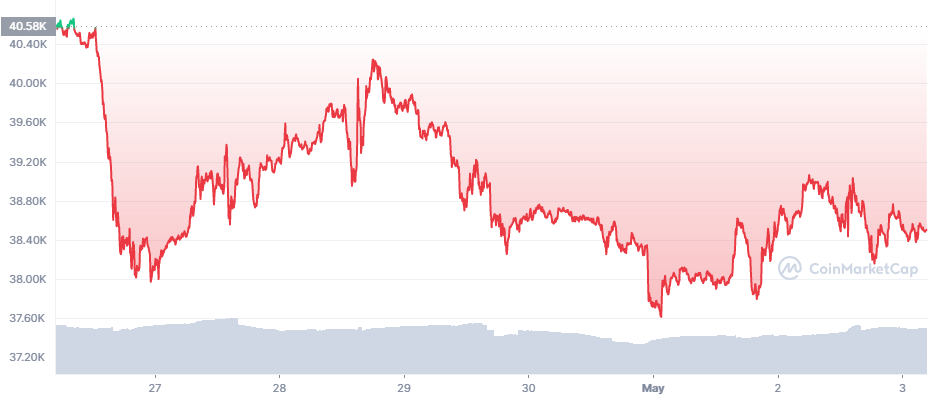Will Bitcoin (BTC) Break to Yearly Lows

Bitcoin (BTC) only managed a small relief rally on Monday, after spending the weekend on shaky ground. The most immediate key level coming next is $37,200, as the coin has entered another period of uncertainty.
After closing in April at $37,714.88, BTC is now roughly down by 50% since its highs in May 2021. BTC ended April in the red, after expectations of a neutral month, or even a historically positive one. Over the course of four weeks, the leading coin abandoned the levels above $46,000 and sparked expectations of a more subdued year.
Will BTC Skip the Bull Market
The expectations for an immediate recovery are now receding for BTC, with expectations of prolonged sideways movement or another dip. In the short term, BTC has made a bullish cross of averages, but with no guarantee of an extended relief rally.
Sentiment remains in the “fear” zone at 28 points on the Crypto Fear and Greed Index. The Rainbow chart tracker is at levels suggesting the potential for accumulation.
BTC has also slid more gradually in the past month, with no recent big capitulation event. But there are expectations for a dip as low as $21,000, turning BTC into a relative bargain at least based on the Rainbow Chart.
However, even a capitulation is not a guaranteed price move. BTC may also rally in the short term, especially when traders may try to deliberately liquidate some positions.
Additionally, at this price range, BTC is close to the accumulation price of Tesla, Inc. There are additional signs of building up large-scale wallets.
BTC More Successful than DeFi
DeFi has achieved a significant turnover. However, altcoins remain much more volatile in comparison to BTC. DeFi as a whole has underperformed some of the BTC price moves.
This is one of the reasons why more DeFi projects are trying to tap BTC as collateral, to hedge the value of their project. Despite price moves, BTC remains much less volatile.
BTC also outperforms tokens and coins that rally in the short term, then lose 90% of their value. Despite support from stablecoins, less liquid assets always have deeper losses when BTC slides even a little.
BTC Tries for Currency Adoption
BTC adopted as legal tender has been tenuous at best over the past 13 years. Yet lately, countries are adopting BTC for the technology and the potential for a hedge against inflation.
Despite volatility, BTC still behaves as a hard currency and may have local value when used directly.
The chief argument against BTC is its high energy usage. However, new data show up to 58% of the network runs on renewable or excess fuels, most commonly hydroelectric power and gas flares. BTC is also created faster with more powerful electronics, while the network grows safer with more than 15,000 nodes.
Is BTC Close to its Bottom
BTC is at another crossroads where various indicators give mixed signals. On one hand, hindsight shows BTC is in much better shape compared to previous price periods. On the other hand, Glassnode data show BTC runs in a way that suggests an ongoing and deep bear market.
Some buyers are currently barely in the money, and holding onto the assets may be much harder as BTC erases more value since its all-time high.
But the metrics also suggest a move to accumulation, instead of outright capitulation and panic. Currently, 70% of buyers are still in the money even after the heavy drop, especially after the BTC rally from the 2020 lows. Dedication to holding from large entities also means BTC may not behave as during previous bear markets.
The BTC market cap dominance expanded to 42.5%, on top of unraveling altcoins. Crypto usage has grown, but even the most active projects cannot promise ongoing profitability.
Even power projects like Solana (SOL) and Terra (LUNA) are down by more than 14% in a week, leading the losses among top 10 coins and tokens by market capitalization. SOL fell after having to stop its network for seven hours and cautioned against unlimited NFT mints. LUNA tracked back closer to $80.
Dogecoin (DOGE), an indicator of interest in risk, fell to $0.12, losing 15% week-on-week. DOGE returned to its usual stagnant level from the past months.
Crypto weakness beyond BTC streams from the caution about DeFi projects, which work well during bull markets but may cause excessive downside as prices correct. Ethereum (ETH) remains with a higher dominance, while keeping above $2,800. The delay of ETH 2.0 is also adding to the price weakness, though ETH gets support from regular fee burns and more tokens locked in the ETH 2.0 smart contract.

Uphold makes buying crypto with popular currencies like USD, EUR and GBP very simple with its convenient options to swap between crypto, fiat, equities, and precious metals.

With over 50 coins and an obsession with security, Kraken is one of the safest places to buy and trade crypto.

Kraken has a good reputation for security and protection of your funds and operates across the USA (except NY), Canada, the EU and Japan

Based in Charleston, South Carolina. Serves over 184 countries and has done over $4 billion in transactions. Offers convenient options to swap between crypto, fiat, equities, and precious metals.

A beginners guide to candlesticks, trend line, indicators and chart patterns

A roundup of the main exchanges in Australia allow you to quickly buy Bitcoin and other crypto on your card

An innovative digital asset utilizing a fully decentralized consensus protocol called Ourobouros. The network aims to compete with Ethereum in offering smart contract functionalities. However it is lightyears behind Ethereum in terms of adoption.

IOTA is a feeless crypto using a DAG rather than a blockchain. It aims to be the currency of the Internet of things and a machine economy.